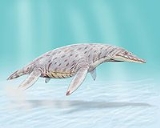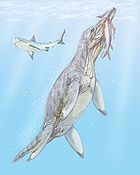
Polyptychodon
Encyclopedia
Polyptychodon is an extinct genus
of sauropterygia
n reptile
belonging to the family
Pliosaur
idae that lived during the Cretaceous
. Its fossil
s have been found in Europe
and North America
.
 The type species
The type species
, P. interruptus is known from Albian
stage deposits from England
. Greensand Formation pliosaur teeth and vertebrae from England and eastern France have long been placed within this poorly known genus. Comparison between French
Albian-aged isolated vertebrae and Kronosaurus
suggests a size of approximately 7 m for Polyptychodon.
One species is known from North America (P. hudsoni, holotytpe = SMM 60313). It is known from Turonian
stage rocks of Dallas, Texas
.
Genus
In biology, a genus is a low-level taxonomic rank used in the biological classification of living and fossil organisms, which is an example of definition by genus and differentia...
of sauropterygia
Sauropterygia
Sauropterygia were a group of very successful aquatic reptiles that flourished during the Mesozoic before they became extinct at the end of the era. They were united by a radical adaptation of their shoulder, designed to support powerful flipper strokes...
n reptile
Reptile
Reptiles are members of a class of air-breathing, ectothermic vertebrates which are characterized by laying shelled eggs , and having skin covered in scales and/or scutes. They are tetrapods, either having four limbs or being descended from four-limbed ancestors...
belonging to the family
Family (biology)
In biological classification, family is* a taxonomic rank. Other well-known ranks are life, domain, kingdom, phylum, class, order, genus, and species, with family fitting between order and genus. As for the other well-known ranks, there is the option of an immediately lower rank, indicated by the...
Pliosaur
Pliosaur
Pliosauroidea is an extinct clade of marine reptiles. Pliosauroids, also commonly known as pliosaurs, are known from the Jurassic and Cretaceous Periods. The pliosauroids were short-necked plesiosaurs with large heads and massive toothed jaws. These swimming reptiles were not dinosaurs but distant...
idae that lived during the Cretaceous
Cretaceous
The Cretaceous , derived from the Latin "creta" , usually abbreviated K for its German translation Kreide , is a geologic period and system from circa to million years ago. In the geologic timescale, the Cretaceous follows the Jurassic period and is followed by the Paleogene period of the...
. Its fossil
Fossil
Fossils are the preserved remains or traces of animals , plants, and other organisms from the remote past...
s have been found in Europe
Europe
Europe is, by convention, one of the world's seven continents. Comprising the westernmost peninsula of Eurasia, Europe is generally 'divided' from Asia to its east by the watershed divides of the Ural and Caucasus Mountains, the Ural River, the Caspian and Black Seas, and the waterways connecting...
and North America
North America
North America is a continent wholly within the Northern Hemisphere and almost wholly within the Western Hemisphere. It is also considered a northern subcontinent of the Americas...
.

Type species
In biological nomenclature, a type species is both a concept and a practical system which is used in the classification and nomenclature of animals and plants. The value of a "type species" lies in the fact that it makes clear what is meant by a particular genus name. A type species is the species...
, P. interruptus is known from Albian
Albian
The Albian is both an age of the geologic timescale and a stage in the stratigraphic column. It is the youngest or uppermost subdivision of the Early/Lower Cretaceous epoch/series. Its approximate time range is 112.0 ± 1.0 Ma to 99.6 ± 0.9 Ma...
stage deposits from England
England
England is a country that is part of the United Kingdom. It shares land borders with Scotland to the north and Wales to the west; the Irish Sea is to the north west, the Celtic Sea to the south west, with the North Sea to the east and the English Channel to the south separating it from continental...
. Greensand Formation pliosaur teeth and vertebrae from England and eastern France have long been placed within this poorly known genus. Comparison between French
France
The French Republic , The French Republic , The French Republic , (commonly known as France , is a unitary semi-presidential republic in Western Europe with several overseas territories and islands located on other continents and in the Indian, Pacific, and Atlantic oceans. Metropolitan France...
Albian-aged isolated vertebrae and Kronosaurus
Kronosaurus
Kronosaurus is an extinct genus of short-necked pliosaur. It was among the largest pliosaurs, and is named after the leader of the Greek Titans, Cronus.-Discovery and species:Kronosaurus lived in the Early Cretaceous Period ....
suggests a size of approximately 7 m for Polyptychodon.
One species is known from North America (P. hudsoni, holotytpe = SMM 60313). It is known from Turonian
Turonian
The Turonian is, in the ICS' geologic timescale, the second age in the Late Cretaceous epoch, or a stage in the Upper Cretaceous series. It spans the time between 93.5 ± 0.8 Ma and 89.3 ± 1 Ma...
stage rocks of Dallas, Texas
Texas
Texas is the second largest U.S. state by both area and population, and the largest state by area in the contiguous United States.The name, based on the Caddo word "Tejas" meaning "friends" or "allies", was applied by the Spanish to the Caddo themselves and to the region of their settlement in...
.
External links
- Polyptychodon in the Paleobiology DatabasePaleobiology Database' is an online resource for information on the distribution and classification of fossil animals, plants, and microorganisms.-History:The Paleobiology Database was founded in 2000. It has been funded by the National Science Foundation and the Australian Research Council...

